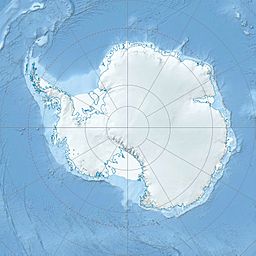Mount Haddington facts for kids
Quick facts for kids Mount Haddington |
|
|---|---|
| Highest point | |
| Elevation | 1,630 m (5,350 ft) |
| Prominence | 1,630 m (5,350 ft) |
| Listing | Ultra |
| Geography | |
| Location | James Ross Island, Antarctica |
| Geology | |
| Mountain type | Shield volcano |
| Volcanic field | James Ross Island Volcanic Group |
| Last eruption | Unknown |
Mount Haddington is a huge volcano located on James Ross Island in Antarctica. It stands tall at 1,630 m (5,350 ft) and is about 60 km (37 mi) wide. This mountain is a special type of volcano called a shield volcano.
Contents
What is a Shield Volcano?
A shield volcano gets its name because it looks like a warrior's shield lying on the ground. It has gentle slopes and is built up over time by many runny lava flows. Mount Haddington has had many eruptions, especially under ice, which created unique landforms.
How Mount Haddington Formed
Mount Haddington formed over millions of years. Most of its growth happened during the Miocene and Pliocene epochs. These are periods in Earth's history that ended about 2.5 million years ago.
Eruptions Under Ice
Many of Mount Haddington's eruptions happened beneath thick ice sheets. When lava erupts under ice, it cools very quickly and forms special shapes. These eruptions created many tuyas, which are flat-topped, steep-sided volcanoes that look like mesas. Some single eruptions from Mount Haddington were even bigger than a whole normal-sized volcano!
Recent Volcanic Activity
Even though it's an old volcano, Mount Haddington has had more recent eruptions. On its slopes, you can find younger tuff cones and pyroclastic cones. These are small, cone-shaped hills made from volcanic ash and rock fragments. Some of these cones, especially on the eastern side, might have formed in the last few thousand years.
Lava Flows and Deltas
When lava flowed out of Mount Haddington, it often reached the sea. These effusive eruptions (where lava flows out gently) created large lava deltas. These deltas are made of a mix of broken volcanic glass and lava flows.
Discovering Mount Haddington
Mount Haddington was first seen on December 31, 1842. It was discovered by the Ross expedition, a group of scientists exploring Antarctica. This expedition lasted from 1839 to 1843 and was led by James Clark Ross. Ross named the mountain after the Earl of Haddington, who was an important leader in the British Navy at the time.
See also
 In Spanish: Monte Haddington para niños
In Spanish: Monte Haddington para niños
- List of Ultras of Antarctica
- List of volcanoes in Antarctica


